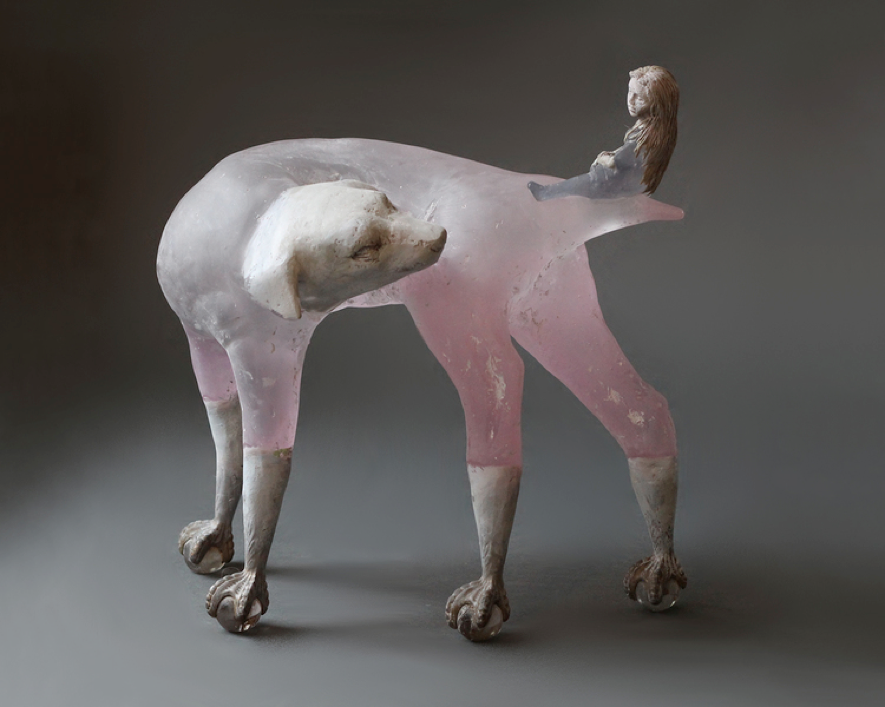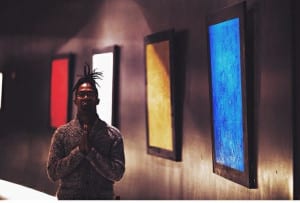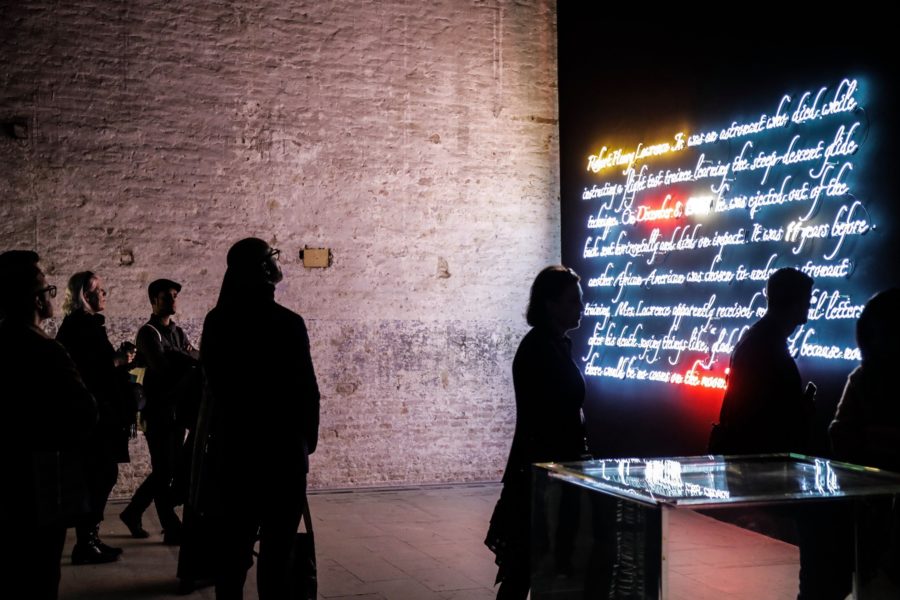Shortly before last fall’s election, Hillary Clinton, reveling in her newfound “nasty woman” status, quipped at the Alfred Smith Memorial Dinner that she was “up against the highest, hardest stained-glass ceiling,” joking that she would not soon be made a saint even though surviving the debates was something of a miracle. The “stained glass ceiling” comment started us on a train of thought that began with glass ceilings in politics and the art world and eventually lead our minds to an exhibition of stained glass art by Judith Schaechter at the Claire Oliver Gallery. At this point in history, we thought it might be a good time to explore contemporary women artists working in glass. Here, we will discuss five women artists working in glass who we think you should get to know a little bit better.

It was a warm late summer day in Chelsea when we first encountered Judith Schaecter’s stained glass artwork. We see a lot of artwork, so it is unusual to find an artist that completely surprises you. Schaecther’s artwork has its roots in medieval imagery and technique but is completely contemporary. Her work is striking in its complexity. The imagery it is powerful and perplexing. The colors and illuminated glow of her stained glass work are stunning, but the images of tormented women are challenging and mysterious.
Schaecter says of her work. “I found the beauty of glass to be the perfect counterpoint to ugly and difficult subjects. It’s a blatant reference to holiness or some type of “supernatural” state of being. In terms of my figures, although they are intended to be ordinary people doing ordinary things, I see them as having much in common with the old medieval windows of saints and martyrs.” Her imagery references medieval stained glass, but the glass is not painted in the manner medieval glass is painted. Gallery director Ian Rubinstein showed us samples of how Schaecter produces her work. She uses the same type of glass medieval artists used but instead of painting on it she carves into it producing various values. She then layers sheets of different colored glass to produce new colors the way a painter would mix paint on a palette. This is an incredibly time-consuming and difficult process. We were amazed by her technical virtuosity and her disquieting imagery. While at the gallery we sat down with gallery owner Claire Oliver who generously shared her thoughts on glass in contemporary art. Claire is deeply interested in the process of art-making. We talked about various women working in glass, and about Beth Lipman, whose work we had also seen previously in Claire’s gallery.

Beth Lipman’s glasswork is also a technical tour de force. Using blown glass is her preferred form of expression. Lipman’s work can be whimsical in nature. Her recent commission for the Chipstone Foundation, “Secretary with Chipmunk” is a homage to the founders of the Chipstone Foundation Polly and Stanley Stone. Stanley’s nickname for his wife Polly was “Chipmunk,” hence the name of the foundation and the title of Lipman’s piece (the piece also includes a sculpture of a chipmunk). For the commission Lipman took an 18th century secretary desk and removed parts of it which she then burned. She mixed the ashes into the molten glass that she then used for the sculpture. The result is a baroque compilation of sculpted glass which transforms the desk from an 18th-century piece of furniture into a stunning 21st-century artwork.
We asked Beth if she thought her work was whimsical in nature. She replied “I agree that there is a whimsical nature to the glass still lifes. The process of working in hot glass without molds is expressive by nature and the fluidity of the material is captured in the final compositions. In the case of Secretary with Chipmunk, the title, while being whimsical, also alludes to the history of the Chipstone Foundation. The scale and volume of the work can aptly be described as a folly. Folly requires a level of commitment that is at once noble and futile.”

Lauren Fensterstock is not singularly a “glass” artist. She is, in fact, a mixed media artist who withdrew from the first glass blowing class she ever took because she was afraid of failing it. She has worked in all types of materials, including gold, paper and even spiders.
Recently, she was awarded a residency at the Glass Museum in Tacoma, Washington. The residency gave Lauren a chance to investigate an obsession she has had for the last decade called the Claude Glass. The Claude Glass is a 17th-century optical device made from black convex glass. Fensterstock said this about her obsession: “Although I have made a huge body of work inspired by this mirror, I have never actually held one or known what it is to look through this lens. I was recently invited to participate in a residency at the Museum of Glass in Tacoma where I was able to collaborate with their masterful team. I designed a series of handheld and large wall-hanging glass mirrors and worked with their artists to bring them to life. It was an amazing process that has transformed the future direction of my work. To hold the mirror in my own hands and to see its reflections is something that can not be explained in theory or concept, it has to be experienced by the body.” Through the residency and the experience of creating her own version of the Claude Glass, Fensterstock feels vindicated from withdrawing from her first glassblowing class. Lauren is currently in the process of renting a 16-foot long truck and bringing her work to Manhattan for the Volta Art Fair during Armory week March 1-5, Volta takes place next door to The Armory Show Pier 90, 711 12th Avenue at West 48th Street.

Christina Bothwell studied painting at Pennsylvania Academy of the Fine Arts in Philadelphia. Bothwell eventually started working with glass, when she did, she felt an immediate connection. Finding the translucency and the way glass transmitted light perfect for the spiritual realm she was trying to express. The resulting figures are a combination of pit fired clay and cast glass. Bothwell goes through a complex process to create her art.
First, she models the head in clay, then fires it. She then uses beeswax to model the parts that will be cast in glass. Then she makes molds and goes through a lost wax process similar to the way bronze sculptures are cast. She then fills the mold with chunks of glass, heats the mold to 1400 degrees, which melts the glass. Depending on the thickness of the glass it can take days or weeks to cool down enough to remove the mold. She then grinds, paints and attaches the other elements of the sculpture to the class. It is a very time consuming and laborious process. Bothwell’s subject matter and the cast glass give her work a spiritual dimension. She says about her work “I am interested in expressing my belief that we are more than just our physical bodies. I try to suggest the soul, and sometimes our inner, private, creative lives. My subject matter includes babies, animals, and children to me babies and children are perfect metaphors for innocence and vulnerability, qualities that make us human.”

Amber Cowan was drawn to glass as a young child by frosted pink elephant swizzle sticks stored in her parents’ basement. Later in life, her interest was renewed because she saw it as a constantly challenging media. She creates her work from vintage pressed glass, using a technique know as lampwork in which the class is heated in front of a glass torch and manipulated by hand. Her work, which is a combination of floral and animal imagery, is delicate and complex.
At first glance, Cowan’s work reminds one of a seashell crafts found at the beach however as the viewer investigates her work one is drawn into its complexity and imagery. The sculptures are small ecosystems of flowers with occasional miniature creatures. It is like you are looking at a small section of a tropical coral reef or a micro ecosystem in the rain forest. They bring to mind the delicate nature of life on our planet and the need to preserve it. Cowan says this about her work: “My work can be viewed on a number of levels. I think on the most surface level my work is beautiful and enchanting. I want the viewer to get lost in the worlds that I create. My work is created out of vintage pressed glass, so it is also about the history of the material.” On the surface level, Cowan’s work is beautiful and delicate, but a deeper understanding and appreciation of the natural world can also be inspired by the work.
You can see the work of Judith Schaechter and Lauren Fensterstock at Claire Oliver Gallery. Christina Bothwell and Amber Cowan’s work can be seen at the Heller Gallery.
all images// courtesy of the artist and gallery



